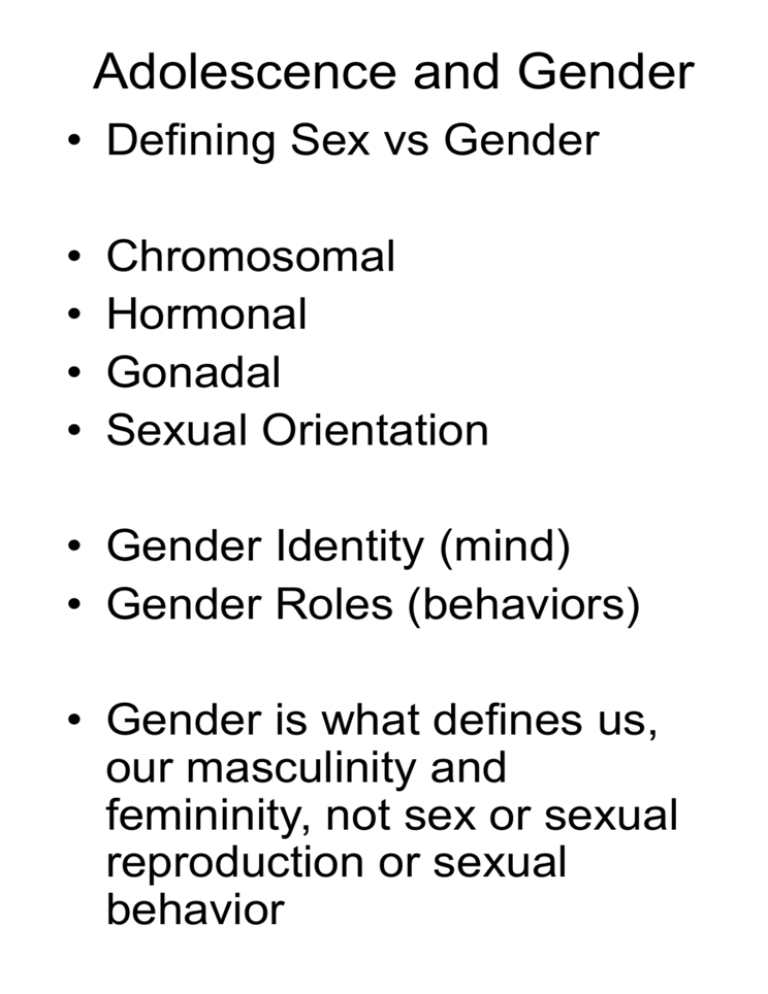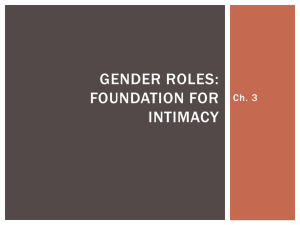
Adolescence and Gender
• Defining Sex vs Gender
•
•
•
•
Chromosomal
Hormonal
Gonadal
Sexual Orientation
• Gender Identity (mind)
• Gender Roles (behaviors)
• Gender is what defines us,
our masculinity and
femininity, not sex or sexual
reproduction or sexual
behavior
Differential Gender Socialization
• Parents treat males / females differently
– Girls treated less physically, more verbally
• Out-role behavior is heavily punished by
peers
• Middle childhood, rules become more
flexible
• During puberty, though, rules become
more rigid again
• Mostly imposed by peers
• Traditionally, males have received more
attention in school, but recent research
shows girls feel more accepted and
encouraged than males
Cognition and gender
• 1. Kohlberg’s cognitive-developmental
theory of gender
• Gender identity develops around 3
• Gender Permanence develops around 5
• Then M/F select roles – self-socialization
• Adolescents abstract the essence of
feminine and masculine from many different
examples
• 2. Gender schema theory – mental
organization of facts – we selectively
process information based on our gender –
and then conform our behavior to that
template
Female socialization
• Womanhood just happens – not
achieved
• Need to be sheltered from work –
physical exertion would weaken the
uterus – Narrow gender socialization
(traditional cultures)
• Should shelter her developing
sexuality – would entice males (who
we know can’t be controlled) – Narrow
sexual socialization, traditional and
modern cultures). Only in modern
times are girls typically informed of
menarche.
• Typically work with mother, and remain
close to her, throughout life – modified
by marriage
• Techniques for enhancing appearance
– makeup, corsets, hose (foot binding
in China)
Male socialization
• Manhood must be earned –
demonstrated
• Communal manhood – historical,
nontraditional - join the tribe – it is the
males who run the community – males
need to demonstrate desire & ability to
believe in and carry on the traditions –
inherit the rules and the farm – modern
Fraternities
• Provide, Protect, Procreate
• Develop character qualities of diligence &
stamina, courage and fortitude
• Man judged by his character – maturity,
ability to be strong (physically, mentally,
emotionally)
• Modern societies today – Self-made
manhood – economic
• Passionate manhood – be passionate,
fiery, aggressive, a lover
American History
• Industrial rev. brought in new ideals –
become independent – leave home
• E.g., inception of YMCA, YWCA
• Develop morals, physical ability – recall
that the I.R. was a very unhealthy time –
needed to re-emphasize health
• Gender socialization in traditional
cultures becomes BROAD for boys
• Other cultures – tribal – e.g., Italian males
live at home until they marry
• Western cultures today - passionate
manhood – self-expression and selfenjoyment more accepted today (but will
this last in our new time of conservative
values?)
• Today, broad gender socialization for girls,
and narrow sexual socialization
• Narrow gender socialization for boys, and
broad sexual socialization
Gender Intensification Hypothesis
• At puberty, males and females
accentuate their gender
differences, both externally
(physically) and internally
(mentally)
• Hold rigid gender stereotypes
• Intense socialization pressure
• Self-conscious about appearance
• NORC data show gender role
stereotypes have become less rigid
Media and Gender
• Teen magazines relentlessly promote
gender socialization of girls toward
traditional feminine characteristics and
behaviors
• Physical appearance, how to appeal to
boys
• Also trying to influence teens to buy
products – clothes for girls, electronics
for boys
• Main topic on careers for girls was
modeling
• Girls more likely to develop a negative
body image
• Leads to dieting and eating disorders
• Males socialize each other to become
more aggressive – ridicule each other
and women
• Establish a dominance hierarchy
Masculinity, Femininity,
Androgyny
• Judith Gibbons’ cross-cultural study of
gender ideals
• Ideal man & woman = kind & honest
• Low value = money and popularity
• More important for a man to have a good
job
• More important for a woman to be good
looking
• Bem SRI – most desirable M F traits
• Expressive traits – Instrumental traits
• During adolescence, higher self-image is
realted to female androgyny than male
androgyny
• Androgyny may be healthier –
more flexible
• In adolescence, androgyny more
healthy for girls than boys
• Acceptance by peers is highest for
androgynous girls and masculine
boys
• So in modern cultures there is a
narrow gender socialization in
gender traits for boys, but a
broad gender socialization in
traits for girls
Gender socialization as a
source of problems
• Gender Role Strain
– Success, power, competition
– Restrictive emotionality (Alexithymia)
– Restrictive closeness with other men, including
sons
– Conflict between work and family relations
• Males, gender role difficulties usually
include aggression (dominance hierarchy),
competition, suppress emotions, pain, injury,
4 times more likely to commit suicide
• Increases risk-taking behaviors – which
lead to accidents and diseases
• Sexual harassment and abuse
• Girls – focus on physical appearance –
causes stress, pressures girls to define the
self in terms of attractiveness, and perhaps
contributes to eating disorders
• Pressure from boys AND girls
American Minority
Groups
• African American females are more
likely to have qualities that are typically
thought of as more “masculine”
• Self reliance, assertiveness,
perseverance
• Not as vulnerable to eating disorders
• A-A males are perhaps more likely to
accentuate hypermasculine
characteristics
• Latino – F submissive, M machismo
Gender stereotypes in
emerging adulthood
• Stereotypes about work roles,
still present, but fading
• Why do stereotypes exist?
Motivation to BE different.
Male / Female
circumcision
• Much more restrictive for females
• Cultural focus & meaning –
interpretation of female sexual
needs & purposes
• No basis in medical science for
necessity of either male or
female circumcision
Discussion questions
• Emotions
• Roles
• Peer Pressure
• Media influences
• Portrayal of men and women in media
• Sexual socialization
– Males – Broad socialization
– Females – Narrow socialization
• Exception: bisexuality
• Gender socialization
– Roles
• Males
– Traditional – broad
– Modern – “narrow”
• Females
– Traditional – narrow
– Modern - broadening
– Emotional
• Males – narrow
• Females - broad






